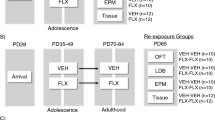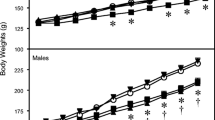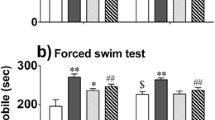Abstract
Fluoxetine (FLX) is prescribed to treat depression and anxiety in adolescent patients. However, FLX has anxiogenic effects during the acute phase of treatment, and caution has been raised due to increased suicidal thinking and behavior. Herein, we sought to study in adolescent (35-day-old) male rats, the effects of short-term FLX treatment (10 mg/kg/day, i.p. for 3–4 days) on hypothalamic–pituitary–adrenal axis activity, serotonin (5-hidroxytriptamine, 5-HT) transporter (SERT) mRNA expression in the dorsal raphe nucleus (DRN), energy balance-related variables and behavioral profiles in the holeboard. Our results revealed that daily FLX administration increased plasma corticosterone (B) concentrations without affecting basal gene expression of corticotrophin releasing hormone in the hypothalamic paraventricular nucleus (PVN) nor of pro-opiomelanocortin in the anterior pituitary. However, FLX had significant effects increasing the mRNA expression of PVN arginine vasopressin (AVP) and reducing SERT mRNA levels in the dorsolateral subdivision of the DRN. In the holeboard, FLX-induced anxiety/emotionality-like behaviors. As expected, FLX treatment was endowed with anorectic effects and reduced body weight gain. Altogether, our study shows that short-term FLX treatment results in physiological, neuroendocrine and behavioral stress-like effects in adolescent male rats. More importantly, considering that the AVP- and 5-HTergic systems: (1) are intimately involved in regulation of the stress response; (2) are regulated by sex hormones and (3) are related to regulation of aggressive behaviors, our results highlight the potential significance of these systems mediating the anxiogenic/emotionality/stress-like responses of adolescent male rats to short-term FLX treatment.






Similar content being viewed by others
References
Adamec R, Burton P, Blundell J, Murphy DL, Holmes A (2006) Vulnerability to mild predator stress in serotonin transporter knockout mice. Behav Brain Res 170:126–140
Aguilera G, Rabadan-Diehl C (2000) Vasopressinergic regulation of the hypothalamic-pituitary-adrenal axis: implications for stress adaptation. Regul Pept 96:23–29
Akana SF, Strack AM, Hanson ES, Horsley CJ, Milligan ED, Bhatnagar S, Dallman MF (1999) Interactions among chronic cold, corticosterone and puberty on energy intake and deposition. Stress 3:131–146
Antoni FA (1993) Vasopressinergic control of pituitary adrenocorticotropin secretion comes of age. Front Neuroendocrinol 14:76–122
Bengel D, Heils A, Petri S, Seemann M, Glatz K, Andrews A, Murphy DL, Lesch KP (1997) Gene structure and 5′-flanking regulatory region of the murine serotonin transporter. Brain Res Mol Brain Res 44:286–292
Benmansour S, Owens WA, Cecchi M, Morilak DA, Frazer A (2002) Serotonin clearance in vivo is altered to a greater extent by antidepressant-induced downregulation of the serotonin transporter than by acute blockade of this transporter. J Neurosci 22:6766–6772
Berton O, Durand M, Aguerre S, Mormede P, Chaouloff F (1999) Behavioral, neuroendocrine and serotonergic consequences of single social defeat and repeated fluoxetine pretreatment in the Lewis rat strain. Neuroscience 92:327–341
Bethea CL, Streicher JM, Mirkes SJ, Sanchez RL, Reddy AP, Cameron JL (2005) Serotonin-related gene expression in female monkeys with individual sensitivity to stress. Neuroscience 132:151–166
Branchi I (2011) The double edged sword of neural plasticity: increasing serotonin levels leads to both greater vulnerability to depression and improved capacity to recover. Psychoneuroendocrinology 36:339–351
Branchi I, Santarelli S, Capoccia S, Poggini S, D’Andrea I, Cirulli F, Alleva E (2013) Antidepressant treatment outcome depends on the quality of the living environment: a pre-clinical investigation in mice. PLoS ONE 8(4):e62226
Bridge JA, Iyengar S, Salary CB, Barbe RP, Birmaher B, Pincus HA, Ren L, Brent DA (2007) Clinical response and risk for reported suicidal ideation and suicide attempts in pediatric antidepressant treatment: a meta-analysis of randomized controlled trials. JAMA 297:1683–1696
Chaouloff F (1993) Physiopharmacological interactions between stress hormones and central serotonergic systems. Brain Res Brain Res Rev 18:1–32
Chen JC, Turiak G, Galler J, Volicer L (1997) Postnatal changes of brain monoamine levels in prenatally malnourished and control rats. Int J Dev Neurosci 15:257–263
Dallman MF, Akana SF, Strack AM, Hanson ES, Sebastian RJ (1995) The neural network that regulates energy balance is responsive to glucocorticoids and insulin and also regulates HPA axis responsivity at a site proximal to CRF neurons. Ann N Y Acad Sci 771:730–742
de Jong TR, Snaphaan LJ, Pattij T, Veening JG, Waldinger MD, Cools AR, Olivier B (2006) Effects of chronic treatment with fluvoxamine and paroxetine during adolescence on serotonin-related behavior in adult male rats. Eur Neuropsychopharmacol 16:39–48
de Vries GJ, Panzica GC (2006) Sexual differentiation of central vasopressin and vasotocin systems in vertebrates: different mechanisms, similar endpoints. Neuroscience 138:947–955
Dinan TG (1996) Serotonin and the regulation of hypothalamic-pituitary-adrenal axis function. Life Sci 58:1683–1694
Dinopoulos A, Dori I, Parnavelas JG (1997) The serotonin innervation of the basal forebrain shows a transient phase during development. Brain Res Dev Brain Res 99:38–52
Doremus TL, Varlinskaya EI, Spear LP (2006) Factor analysis of elevated plus-maze behavior in adolescent and adult rats. Pharmacol Biochem Behav 83:570–577
Emslie GJ, Ryan ND, Wagner KD (2005) Major depressive disorder in children and adolescents: clinical trial design and antidepressant efficacy. J Clin Psychiatry 66(Suppl 7):14–20
Engeland WC, Arnhold MM (2005) Neural circuitry in the regulation of adrenal corticosterone rhythmicity. Endocrine 28:325–332
Engelmann M, Landgraf R, Wotjak CT (2004) The hypothalamic-neurohypophysial system regulates the hypothalamic–pituitary–adrenal axis under stress: an old concept revisited. Front Neuroendocrinol 25:132–149
File SE, Wardill AG (1975a) The reliability of the hole-board apparatus. Psychopharmacologia 44:47–51
File SE, Wardill AG (1975b) Validity of head-dipping as a measure of exploration in a modified hole-board. Psychopharmacologia 44:53–59
File SE, Lister RG, Nutt DJ (1982) The anxiogenic action of benzodiazepine antagonists. Neuropharmacology 21:1033–1037
Filipenko ML, Beilina AG, Alekseyenko OV, Dolgov VV, Kudryavtseva NN (2002) Repeated experience of social defeats increases serotonin transporter and monoamine oxidase a mRNA levels in raphe nuclei of male mice. Neurosci Lett 321:25–28
Fumagalli F, Jones SR, Caron MG, Seidler FJ, Slotkin TA (1996) Expression of mRNA coding for the serotonin transporter in aged vs. young rat brain: differential effects of glucocorticoids. Brain Res 719:225–228
Gomez F, Dallman MF (2001) Manipulation of androgens causes different energetic responses to cold in 60- and 40-day-old male rats. Am J Physiol Regul Integr Comp Physiol 280:R262–R273
Gomez F, Lahmame A, de Kloet ER, Armario A (1996) Hypothalamic-pituitary-adrenal response to chronic stress in five inbred rat strains: differential responses are mainly located at the adrenocortical level. Neuroendocrinology 63:327–337
Gomez F, Houshyar H, Dallman MF (2002) Marked regulatory shifts in gonadal, adrenal, and metabolic system responses to repeated restraint stress occur within a 3-week period in pubertal male rats. Endocrinology 143:2852–2862
Gomez F, Manalo S, Dallman MF (2004) Androgen-sensitive changes in regulation of restraint-induced adrenocorticotropin secretion between early and late puberty in male rats. Endocrinology 145:59–70
Griebel G, Cohen C, Perrault G, Sanger DJ (1999) Behavioral effects of acute and chronic fluoxetine in Wistar–Kyoto rats. Physiol Behav 67:315–320
Hesketh S, Jessop DS, Hogg S, Harbuz MS (2005) Differential actions of acute and chronic citalopram on the rodent hypothalamic–pituitary–adrenal axis response to acute restraint stress. J Endocrinol 185:373–382
Hesketh SA, Leggett JD, Jessop DS (2007) Chronic citalopram treatment does not sensitize the adrenal gland to ACTH (1–24) in rats. J Psychopharmacol 21:885–887
Holmes MC, Antoni FA, Aguilera G, Catt KJ (1986) Magnocellular axons in passage through the median eminence release vasopressin. Nature 319:326–329
Homberg JR, Schubert D, Gaspar P (2010) New perspectives on the neurodevelopmental effects of SSRIs. Trends Pharmacol Sci 31:60–65
Iijima M, Yoshimizu T, Shimazaki T, Tokugawa K, Fukumoto K, Kurosu S, Kuwada T, Sekiguchi Y, Chaki S (2014) Antidepressant and anxiolytic profiles of newly synthesized arginine vasopressin receptor 1B antagonists: TASP0233278 and TASP0390325. Br J Pharmacol 171:3511–3525
Jacobs BL, Azmitia EC (1992) Structure and function of the brain serotonin system. Physiol Rev 72:165–229
Jahng JW, Kim JG, Kim HJ, Kim BT, Kang DW, Lee JH (2007) Chronic food restriction in young rats results in depression- and anxiety-like behaviors with decreased expression of serotonin reuptake transporter. Brain Res 1150:100–107
Jensen JB, Jessop DS, Harbuz MS, Mørk A, Sánchez C, Mikkelsen JD (1999) Acute and long-term treatments with the selective serotonin reuptake inhibitor citalopram modulate the HPA axis activity at different levels in male rats. J Neuroendocrinol 11:465–471
Jørgensen H, Knigge U, Kjaer A, Møller M, Warberg J (2002a) Serotonergic stimulation of corticotropin-releasing hormone and pro-opiomelanocortin gene expression. J Neuroendocrinol 14:788–795
Jørgensen H, Knigge U, Kjaer A, Warberg J (2002b) Serotonergic involvement in stress-induced vasopressin and oxytocin secretion. Eur J Endocrinol 147:815–824
Kalueff AV, Tuohimaa P (2005) The grooming analysis algorithm discriminates between different levels of anxiety in rats: potential utility for neurobehavioural stress research. J Neurosci Methods 143:169–177
Keck ME, Welt T, Muller MB, Uhr M, Ohl F, Wigger A, Toschi NT, Holsboer F, Landgraf R (2003) Reduction of hypothalamic vasopressinergic hyperdrive contributes to clinically relevant behavioural and neuroendocrine effects of chronic paroxetine treatment in a psychopathological rat model. Neuropsychopharmacology 28:235–243
Knoll J, Miklya I, Knoll B, Dalló J (2000) Sexual hormones terminate in the rat: the significantly enhanced catecholaminergic/serotoninergic tone in the brain characteristic to the post-weaning period. Life Sci 67:765–773
Koed K, Linnet K (1997) The serotonin transporter messenger RNA level in rat brain is not regulated by antidepressants. Biol Psychiatry 42:1177–1180
Lau T, Heimann F, Bartsch D, Schloss P, Weber T (2013) Nongenomic, glucocorticoid receptor-mediated regulation of serotonin transporter cell surface expression in embryonic stem cell derived serotonergic neurons. Neurosci Lett 554:115–120
Lauzurica N, García-García L, Fuentes JA, Delgado M (2013) Hypophagia and induction of serotonin transporter gene expression in raphe nuclei of male and female rats after short-term fluoxetine treatment. J Physiol Biochem 69:69–74
Le Poul E, Boni C, Hanoun N, Laporte AM, Laaris N, Chauveau J, Hamon M, Lanfumey L (2000) Differential adaptation of brain 5-HT1A and 5-HT1B receptors and 5-HT transporter in rats treated chronically with fluoxetine. Neuropharmacology 39:110–122
Lee JH, Kim HJ, Kim JG, Ryu V, Kim BT, Kang DW, Jahng JW (2007) Depressive behaviors and decreased expression of serotonin reuptake transporter in rats that experienced neonatal maternal separation. Neurosci Res 58:32–39
Lesch KP, Aulakh CS, Wolozin BL, Tolliver TJ, Hill JL, Murphy DL (1993) Regional brain expression of serotonin transporter mRNA and its regulation by reuptake inhibiting antidepressants. Brain Res Mol Brain Res 17:31–35
Lolait SJ, Stewart LQ, Jessop DS, Young WS 3rd, O’Carroll AM (2007a) The hypothalamic-pituitary-adrenal axis response to stress in mice lacking functional vasopressin V1b receptors. Endocrinology 148:849–856
Lolait SJ, Stewart LQ, Roper JA, Harrison G, Jessop DS, Young WS 3rd, O’Carroll AM (2007b) Attenuated stress response to acute lipopolysaccharide challenge and ethanol administration in vasopressin V1b receptor knockout mice. J Neuroendocrinol 19:543–551
Lowry CA (2002) Functional subsets of serotonergic neurones: implications for control of the hypothalamic-pituitary-adrenal axis. J Neuroendocrinol 14:911–923
Lowry CA, Hale MW, Evans AK, Heerkens J, Staub DR, Gasser PJ, Shekhar A (2008) Serotonergic systems, anxiety, and affective disorder: focus on the dorsomedial part of the dorsal raphe nucleus. Ann N Y Acad Sci 1148:86–94
Ma XM, Levy A, Lightman SL (1997) Emergence of an isolated arginine vasopressin (AVP) response to stress after repeated restraint: a study of both AVP and corticotropin-releasing hormone messenger ribonucleic acid (RNA) and heteronuclear RNA. Endocrinology 138:4351–4357
Makara GB, Varga J, Barna I, Pintér O, Klausz B, Zelena D (2012) The vasopressin-deficient Brattleboro rat: lessons for the hypothalamo–pituitary–adrenal axis regulation. Cell Mol Neurobiol 32:759–766
McQuaid RJ, McInnis OA, Abizaid A, Anisman H (2014) Making room for oxytocin in understanding depression. Neurosci Biobehav Rev 45:305–322
McQueen JK, Wilson H, Sumner BE, Fink G (1999) Serotonin transporter (SERT) mRNA and binding site densities in male rat brain affected by sex steroids. Brain Res Mol Brain Res 63:241–247
Moll GH, Mehnert C, Wicker M, Bock N, Rothenberger A, Rüther E, Huether G (2000) Age-associated changes in the densities of presynaptic monoamine transporters in different regions of the rat brain from early juvenile life to late adulthood. Brain Res Dev Brain Res 119:251–257
Molliver ME (1987) Serotonergic neuronal systems: what their anatomic organization tells us about function. J Clin Psychopharmacol 7(6 Suppl):3S–23S
Moyaho A, Valencia J (2002) Grooming and yawning trace adjustment to unfamiliar environments in laboratory Sprague–Dawley rats (Rattus norvegicus). J Comp Psychol 116:263–269
Murrin LC, Sanders JD, Bylund DB (2007) Comparison of the maturation of the adrenergic and serotonergic neurotransmitter systems in the brain: implications for differential drug effects on juveniles and adults. Biochem Pharmacol 73:1225–1236
Oliva JM, Urigüen L, Pérez-Rial S, Manzanares J (2005) Time course of opioid and cannabinoid gene transcription alterations induced by repeated administration with fluoxetine in the rat brain. Neuropharmacology 49:618–626
Peyron C, Petit JM, Rampon C, Jouvet M, Luppi PH (1998) Forebrain afferents to the rat dorsal raphe nucleus demonstrated by retrograde and anterograde tracing methods. Neuroscience 82:443–468
Rattray M, Michael GJ, Lee J, Wotherspoon G, Bendotti C, Priestley JV (1999) Intraregional variation in expression of serotonin transporter messenger RNA by 5-hydroxytryptamine neurons. Neuroscience 88:169–183
Ricci LA, Melloni RH Jr (2012) Repeated fluoxetine administration during adolescence stimulates aggressive behavior and alters serotonin and vasopressin neural development in hamsters. Behav Neurosci 126:640–653
Romeo RD, McEwen BS (2006) Stress and the adolescent brain. Ann N Y Acad Sci 1094:202–214
Schlosser SF, Almeida OFX, Patchev VK, Yassouridis A, Elands J (1994) Oxytocin-stimulated release of adrenocorticotropin from the rat pituitary is mediated by arginine vasopressin receptors of the V1b type. Endocrinology 135:2058–2063
Serradeil-Le Gal C, Derick S, Brossard G, Manning M, Simiand J, Gaillard R, Griebel G, Guillon G (2003) Functional and pharmacological characterization of the first specific agonist and antagonist for the V1b receptor in mammals. Stress 6:199–206
Silva MT, Alves CR, Santarem EM (1999) Anxiogenic-like effect of acute and chronic fluoxetine on rats tested on the elevated plus-maze. Braz J Med Biol Res 32:333–339
Slawecki CJ (2005) Comparison of anxiety-like behavior in adolescent and adult Sprague–Dawley rats. Behav Neurosci 119:1477–1483
Solano JM, Jacobson L (1999) Glucocorticoids reverse leptin effects on food intake and body fat in mice without increasing NPY mRNA. Am J Physiol 277:E708–E716
Spear LP (2000) The adolescent brain and age-related behavioral manifestations. Neurosci Biobehav Rev 24:417–463
Spiga F, Harrison LR, Wood S, Knight DM, MacSweeney CP, Thomson F, Craighead M, Lightman SL (2009) Blockade of the V(1b) receptor reduces ACTH, but not corticosterone secretion induced by stress without affecting basal hypothalamic–pituitary–adrenal axis activity. J Endocrinol 200:273–283
Spurlock G, Buckland P, O’Donovan M, McGuffin P (1994) Lack of effect of antidepressant drugs on the levels of mRNAs encoding serotonergic receptors, synthetic enzymes and 5HT transporter. Neuropharmacology 33:433–440
Stewart LQ, Roper JA, Young WS 3rd, O’Carroll AM, Lolait SJ (2008) The role of the arginine vasopressin Avp1b receptor in the acute neuroendocrine action of antidepressants. Psychoneuroendocrinology 33:405–415
Takeda H, Tsuji M, Matsumiya T (1998) Changes in head-dipping behavior in the hole-board test reflect the anxiogenic and/or anxiolytic state in mice. Eur J Pharmacol 350:21–29
Tanoue A, Ito S, Honda K, Oshikawa S, Kitagawa Y, Koshimizu TA, Mori T, Tsujimoto G (2004) The vasopressin V1b receptor critically regulates hypothalamic–pituitary–adrenal axis activity under both stress and resting conditions. J Clin Invest 113:302–329
Tarazi FI, Tomasini EC, Baldessarini RJ (1998) Postnatal development of dopamine and serotonin transporters in rat caudate-putamen and nucleus accumbens septi. Neurosci Lett 254:21–24
Torres G, Horowitz JM, Laflamme N, Rivest S (1998) Fluoxetine induces the transcription of genes encoding c-fos, corticotropin-releasing factor and its type 1 receptor in rat brain. Neuroscience 87:463–477
Vacher CM, Frétier P, Créminon C, Calas A, Hardin-Pouzet H (2002) Activation by serotonin and noradrenaline of vasopressin and oxytocin expression in the mouse paraventricular and supraoptic nuclei. J Neurosci 22:1513–1522
Varlinskaya EI, Spear LP (2002) Acute effects of ethanol on social behavior of adolescent and adult rats: role of familiarity of the test situation. Alcohol Clin Exp Res 26:1502–1511
Vollmayr B, Keck S, Henn FA, Schloss P (2000) Acute stress decreases serotonin transporter mRNA in the raphe pontis but not in other raphe nuclei of the rat. Neurosci Lett 290:109–112
Weiss GF, Rogacki N, Fueg A, Buchen D, Suh JS, Wong DT, Leibowitz SF (1991) Effect of hypothalamic and peripheral fluoxetine injection on natural patterns of macronutrient intake in the rat. Psychopharmacology 105:467–476
Wieczorek I, Schulz C, Jarry H, Lehnert H (2001) The effects of the selective serotonin reuptake-inhibitor fluvoxamine on body weight in Zucker rats are mediated by corticotropin-releasing hormone. Int J Obes Relat Metab Disord 25:1566–1569
Acknowledgments
This work has been supported by the grant SAF2005-05738 from the “Ministerio de Educación y Ciencia” of the Spanish Government. We are grateful to Thomas C. Moore and Rocío Naveiras Cabello for their technical support.
Conflict of interest
The authors declare that they have no conflict of interest.
Author information
Authors and Affiliations
Corresponding author
Rights and permissions
About this article
Cite this article
Gomez, F., Venero, C., Viveros, MP. et al. Short-term fluoxetine treatment induces neuroendocrine and behavioral anxiogenic-like responses in adolescent male rats. Exp Brain Res 233, 983–995 (2015). https://doi.org/10.1007/s00221-014-4173-9
Received:
Accepted:
Published:
Issue Date:
DOI: https://doi.org/10.1007/s00221-014-4173-9




